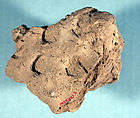Sealing on jar stopper (?)
Not on view
This lump of clay, called a ‘bulla,’ bears four impressions of the same stamp seal, featuring an image of a stylized tree. Based on its shape, this bulla seems to have been a stopper in the mouth of a jar. Seals were ancient accounting tools, used for example to indicate who supplied a commodity, who was responsible for its disbursement, or who received it. In this case, the seal impressions may indicate who supplied the contents of the jar. Once the jar was opened, the bulla was discarded.
This bulla was excavated at Shahr-i Qumis in northern Iran, which has been identified as the ancient city of Hecatompylos, established by the Parthians as the capital of their empire by about 200 B.C. In Greek Hecatompylos means ‘a hundred gates,’ suggesting that the city was quite large. Indeed, the modern archaeological site includes several mounds, only a few of which have been excavated, and a vast area covered with potsherds. This bulla was found in a well at Site IV. The well appears to be have been filled deliberately, but it is difficult to say whether this bulla – and the jar to which it may have been attached – was placed in the well for a specific reason or if it was simply discarded. The large building at Site IV was completely filled with dirt sometime in the late 1st century B.C. or early 1st century A.D., perhaps when the Parthian capital was moved elsewhere and the city’s elite residents left with it.
Due to rights restrictions, this image cannot be enlarged, viewed at full screen, or downloaded.

